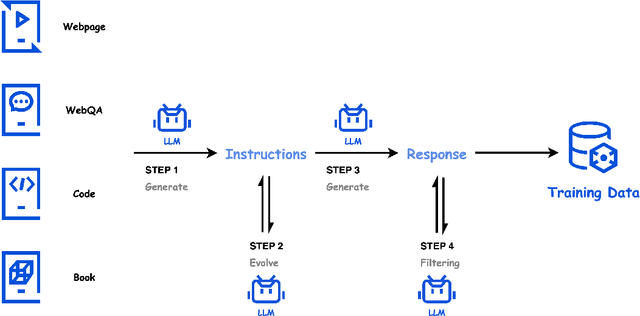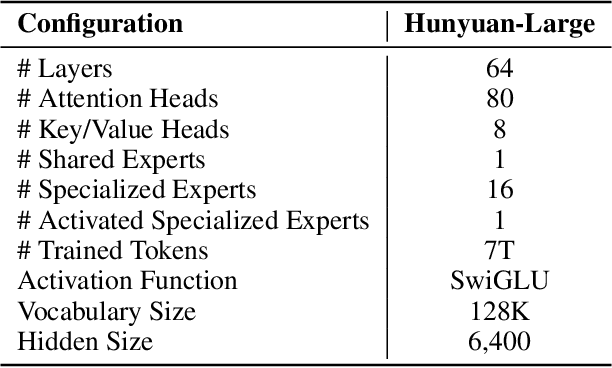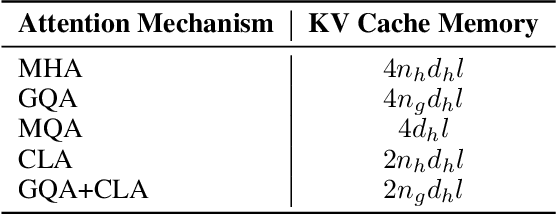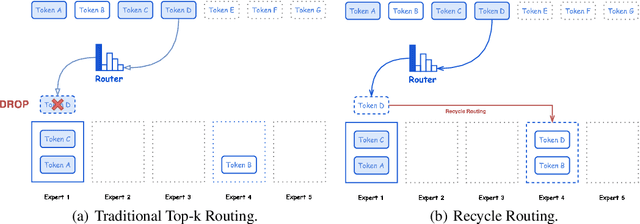Xingwu Sun
TransMamba: Flexibly Switching between Transformer and Mamba
Mar 31, 2025Abstract:Transformers are the cornerstone of modern large language models, but their quadratic computational complexity limits efficiency in long-sequence processing. Recent advancements in Mamba, a state space model (SSM) with linear complexity, offer promising efficiency gains but suffer from unstable contextual learning and multitask generalization. This paper proposes TransMamba, a novel framework that unifies Transformer and Mamba through shared parameter matrices (e.g., QKV and CBx), and thus could dynamically switch between attention and SSM mechanisms at different token lengths and layers. We design the Memory converter to bridge Transformer and Mamba by converting attention outputs into SSM-compatible states, ensuring seamless information flow at TransPoints where the transformation happens. The TransPoint scheduling is also thoroughly explored for further improvements. We conducted extensive experiments demonstrating that TransMamba achieves superior training efficiency and performance compared to baselines, and validated the deeper consistency between Transformer and Mamba paradigms, offering a scalable solution for next-generation sequence modeling.
PatchRec: Multi-Grained Patching for Efficient LLM-based Sequential Recommendation
Jan 25, 2025Abstract:Large Language Models for sequential recommendation (LLM4SR), which transform user-item interactions into language modeling, have shown promising results. However, due to the limitations of context window size and the computational costs associated with Large Language Models (LLMs), current approaches primarily truncate user history by only considering the textual information of items from the most recent interactions in the input prompt. This truncation fails to fully capture the long-term behavioral patterns of users. To address this, we propose a multi-grained patching framework -- PatchRec. It compresses the textual tokens of an item title into a compact item patch, and further compresses multiple item patches into a denser session patch, with earlier interactions being compressed to a greater degree. The framework consists of two stages: (1) Patch Pre-training, which familiarizes LLMs with item-level compression patterns, and (2) Patch Fine-tuning, which teaches LLMs to model sequences at multiple granularities. Through this simple yet effective approach, empirical results demonstrate that PatchRec outperforms existing methods, achieving significant performance gains with fewer tokens fed to the LLM. Specifically, PatchRec shows up to a 32% improvement in HR@20 on the Goodreads dataset over uncompressed baseline, while using only 7% of the tokens. This multi-grained sequence modeling paradigm, with an adjustable compression ratio, enables LLMs to be efficiently deployed in real-world recommendation systems that handle extremely long user behavior sequences.
Scaling Laws for Floating Point Quantization Training
Jan 05, 2025



Abstract:Low-precision training is considered an effective strategy for reducing both training and downstream inference costs. Previous scaling laws for precision mainly focus on integer quantization, which pay less attention to the constituents in floating-point quantization and thus cannot well fit the LLM losses in this scenario. In contrast, while floating-point quantization training is more commonly implemented in production, the research on it has been relatively superficial. In this paper, we thoroughly explore the effects of floating-point quantization targets, exponent bits, mantissa bits, and the calculation granularity of the scaling factor in floating-point quantization training performance of LLM models. While presenting an accurate floating-point quantization unified scaling law, we also provide valuable suggestions for the community: (1) Exponent bits contribute slightly more to the model performance than mantissa bits. We provide the optimal exponent-mantissa bit ratio for different bit numbers, which is available for future reference by hardware manufacturers; (2) We discover the formation of the critical data size in low-precision LLM training. Too much training data exceeding the critical data size will inversely bring in degradation of LLM performance; (3) The optimal floating-point quantization precision is directly proportional to the computational power, but within a wide computational power range, we estimate that the best cost-performance precision lies between 4-8 bits.
Enhancing Contrastive Learning Inspired by the Philosophy of "The Blind Men and the Elephant"
Dec 21, 2024



Abstract:Contrastive learning is a prevalent technique in self-supervised vision representation learning, typically generating positive pairs by applying two data augmentations to the same image. Designing effective data augmentation strategies is crucial for the success of contrastive learning. Inspired by the story of the blind men and the elephant, we introduce JointCrop and JointBlur. These methods generate more challenging positive pairs by leveraging the joint distribution of the two augmentation parameters, thereby enabling contrastive learning to acquire more effective feature representations. To the best of our knowledge, this is the first effort to explicitly incorporate the joint distribution of two data augmentation parameters into contrastive learning. As a plug-and-play framework without additional computational overhead, JointCrop and JointBlur enhance the performance of SimCLR, BYOL, MoCo v1, MoCo v2, MoCo v3, SimSiam, and Dino baselines with notable improvements.
DHCP: Detecting Hallucinations by Cross-modal Attention Pattern in Large Vision-Language Models
Nov 27, 2024



Abstract:Large vision-language models (LVLMs) have demonstrated exceptional performance on complex multimodal tasks. However, they continue to suffer from significant hallucination issues, including object, attribute, and relational hallucinations. To accurately detect these hallucinations, we investigated the variations in cross-modal attention patterns between hallucination and non-hallucination states. Leveraging these distinctions, we developed a lightweight detector capable of identifying hallucinations. Our proposed method, Detecting Hallucinations by Cross-modal Attention Patterns (DHCP), is straightforward and does not require additional LVLM training or extra LVLM inference steps. Experimental results show that DHCP achieves remarkable performance in hallucination detection. By offering novel insights into the identification and analysis of hallucinations in LVLMs, DHCP contributes to advancing the reliability and trustworthiness of these models.
Mitigating Hallucination in Multimodal Large Language Model via Hallucination-targeted Direct Preference Optimization
Nov 15, 2024Abstract:Multimodal Large Language Models (MLLMs) are known to hallucinate, which limits their practical applications. Recent works have attempted to apply Direct Preference Optimization (DPO) to enhance the performance of MLLMs, but have shown inconsistent improvements in mitigating hallucinations. To address this issue more effectively, we introduce Hallucination-targeted Direct Preference Optimization (HDPO) to reduce hallucinations in MLLMs. Unlike previous approaches, our method tackles hallucinations from their diverse forms and causes. Specifically, we develop three types of preference pair data targeting the following causes of MLLM hallucinations: (1) insufficient visual capabilities, (2) long context generation, and (3) multimodal conflicts. Experimental results demonstrate that our method achieves superior performance across multiple hallucination evaluation datasets, surpassing most state-of-the-art (SOTA) methods and highlighting the potential of our approach. Ablation studies and in-depth analyses further confirm the effectiveness of our method and suggest the potential for further improvements through scaling up.
More Expressive Attention with Negative Weights
Nov 14, 2024Abstract:We propose a novel attention mechanism, named Cog Attention, that enables attention weights to be negative for enhanced expressiveness, which stems from two key factors: (1) Cog Attention can shift the token deletion and copying function from a static OV matrix to dynamic QK inner products, with the OV matrix now focusing more on refinement or modification. The attention head can simultaneously delete, copy, or retain tokens by assigning them negative, positive, or minimal attention weights, respectively. As a result, a single attention head becomes more flexible and expressive. (2) Cog Attention improves the model's robustness against representational collapse, which can occur when earlier tokens are over-squashed into later positions, leading to homogeneous representations. Negative weights reduce effective information paths from earlier to later tokens, helping to mitigate this issue. We develop Transformer-like models which use Cog Attention as attention modules, including decoder-only models for language modeling and U-ViT diffusion models for image generation. Experiments show that models using Cog Attention exhibit superior performance compared to those employing traditional softmax attention modules. Our approach suggests a promising research direction for rethinking and breaking the entrenched constraints of traditional softmax attention, such as the requirement for non-negative weights.
Hunyuan-Large: An Open-Source MoE Model with 52 Billion Activated Parameters by Tencent
Nov 05, 2024



Abstract:In this paper, we introduce Hunyuan-Large, which is currently the largest open-source Transformer-based mixture of experts model, with a total of 389 billion parameters and 52 billion activation parameters, capable of handling up to 256K tokens. We conduct a thorough evaluation of Hunyuan-Large's superior performance across various benchmarks including language understanding and generation, logical reasoning, mathematical problem-solving, coding, long-context, and aggregated tasks, where it outperforms LLama3.1-70B and exhibits comparable performance when compared to the significantly larger LLama3.1-405B model. Key practice of Hunyuan-Large include large-scale synthetic data that is orders larger than in previous literature, a mixed expert routing strategy, a key-value cache compression technique, and an expert-specific learning rate strategy. Additionally, we also investigate the scaling laws and learning rate schedule of mixture of experts models, providing valuable insights and guidances for future model development and optimization. The code and checkpoints of Hunyuan-Large are released to facilitate future innovations and applications. Codes: https://github.com/Tencent/Hunyuan-Large Models: https://huggingface.co/tencent/Tencent-Hunyuan-Large
Exploring Forgetting in Large Language Model Pre-Training
Oct 22, 2024Abstract:Catastrophic forgetting remains a formidable obstacle to building an omniscient model in large language models (LLMs). Despite the pioneering research on task-level forgetting in LLM fine-tuning, there is scant focus on forgetting during pre-training. We systematically explored the existence and measurement of forgetting in pre-training, questioning traditional metrics such as perplexity (PPL) and introducing new metrics to better detect entity memory retention. Based on our revised assessment of forgetting metrics, we explored low-cost, straightforward methods to mitigate forgetting during the pre-training phase. Further, we carefully analyzed the learning curves, offering insights into the dynamics of forgetting. Extensive evaluations and analyses on forgetting of pre-training could facilitate future research on LLMs.
Continuous Speech Tokenizer in Text To Speech
Oct 22, 2024Abstract:The fusion of speech and language in the era of large language models has garnered significant attention. Discrete speech token is often utilized in text-to-speech tasks for speech compression and portability, which is convenient for joint training with text and have good compression efficiency. However, we found that the discrete speech tokenizer still suffers from information loss. Therefore, we propose a simple yet effective continuous speech tokenizer and a text-to-speech model based on continuous speech tokens. Our results show that the speech language model based on the continuous speech tokenizer has better continuity and higher estimated Mean Opinion Scores (MoS). This enhancement is attributed to better information preservation rate of the continuous speech tokenizer across both low and high frequencies in the frequency domain.
 Add to Chrome
Add to Chrome Add to Firefox
Add to Firefox Add to Edge
Add to Edge